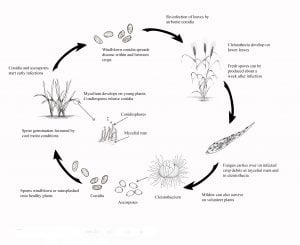Powdery mildew is caused by the fungus Blumeria graminis f. sp hordei and is most common in early sown crops with good canopy cover and good nitrogen nutrition. Symptoms are usually first observed during tillering, but the disease does not normally persist beyond ear emergence. Losses are typically minimal in Victoria but can be as much as 25 per cent in heavily-infected crops, which has been observed in South and Western Australia.
What to Look For
At first, small, yellow spots appear on the leaves. Several days later a white fluffy fungus can be seen in these spots. The fungus can infect all above-ground parts of the plant including the head. It causes yellowing and early death of leaves. Later in the season the fungus produces small black specks. These are commonly found in old infections near the base of the plant.
Disease Cycle
Powdery mildew is an obligate parasite that lives on living barley plants. Infection produces masses of tiny, white spores which are spread when blown by the wind. Infection occurs when there is high humidity from dew and temperatures be- tween 15-25°C. Mildew symptoms usually appear five to seven days after infection. The fungus can multiply quickly, and crops can become heavily diseased within four to five weeks of the first signs of the disease. The disease carries over from one season to the next on volunteers and grasses. Mildews are host specific and, therefore, mildew from barley will not infect wheat.
Disease cycle of powdery mildew on cereals. Illustration by Kylie Fowler
Management
Cultural
Remove volunteer barley plants by grazing and/or herbicides to reduce inoculum loads. Crop rotations are not an effective control of powdery mildew as spores can be readily blown onto a healthy crop from diseased crops in the district.
Cultivars
Barley varieties vary in their susceptibility to powdery mildew so consult a current Victorian Cereal Disease Guide or the NVT website to determine risk.
Chemicals
Some seed treatment fungicides will suppress powdery mildew for 6-8 weeks following sowing. This form of control is recommended in barley crops that are sown early and in areas prone to powdery mildew. Foliar fungicides are available for suppression of powdery mildew and are best applied before the disease has infected 5 per cent of leaf area of the lowest green leaves. There is reduced sensitivity of Powdery Mildew to some triazole fungicides in Western Australia resulting in foliar fungicide application being ineffective. Crops in eastern Australia should be monitored for signs of reduced sensitivity by powdery mildew to fungicides and samples submitted to Agriculture Victoria DJPR for testing.
Please note: This book is also available on AppleBooks




